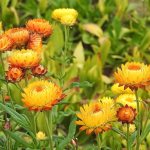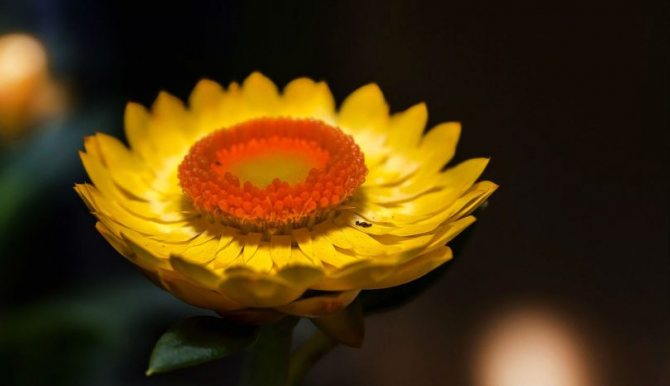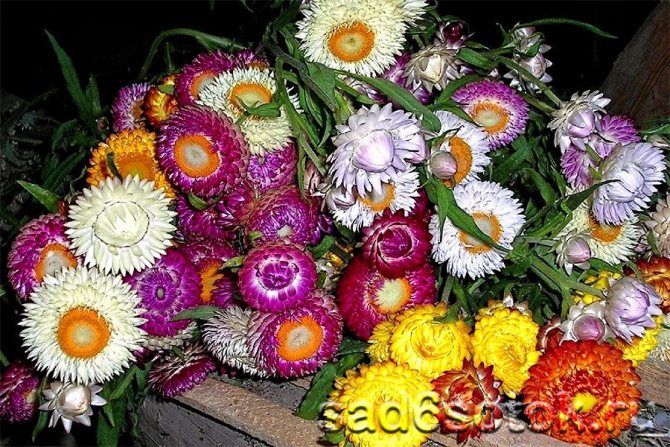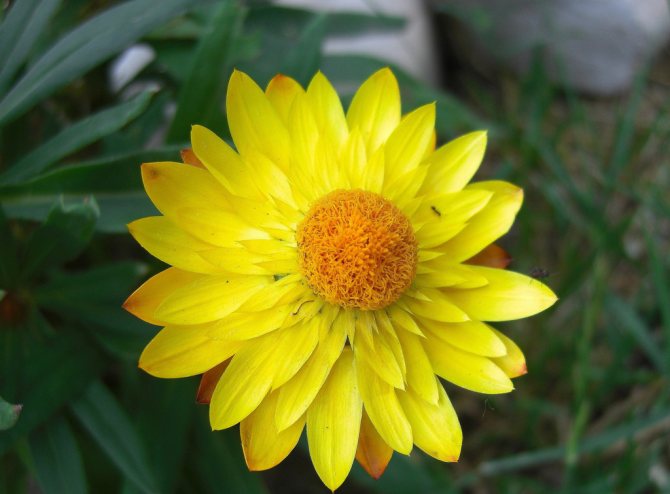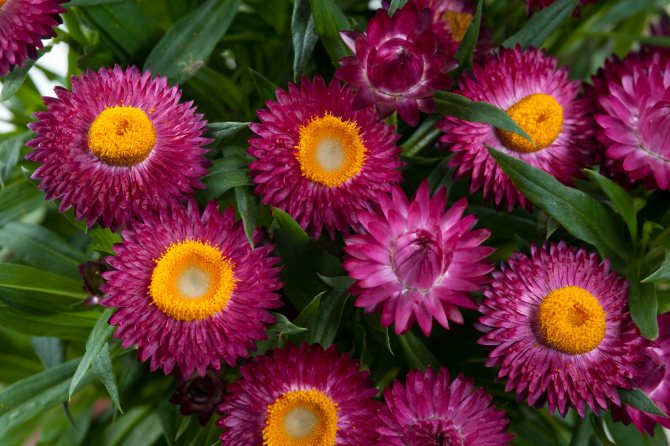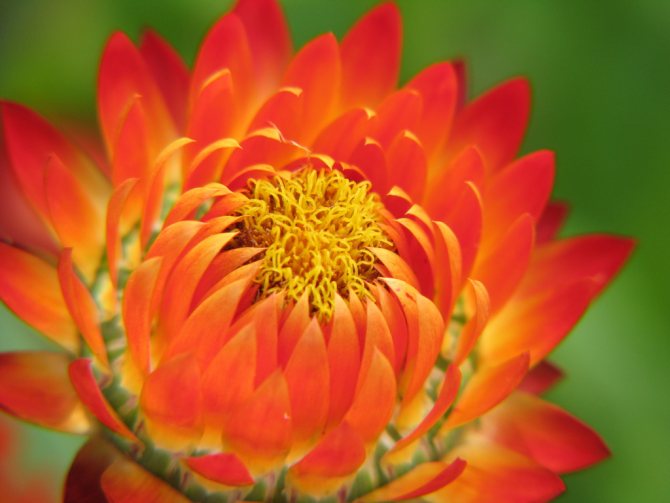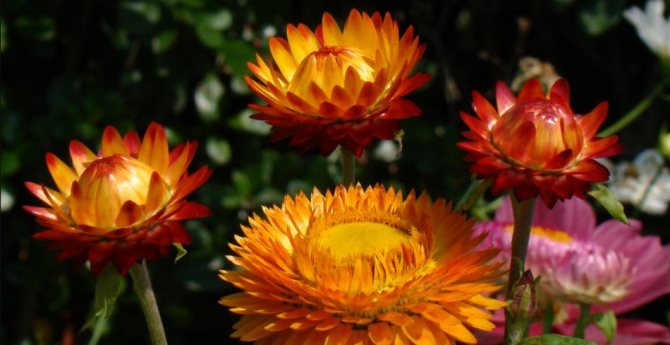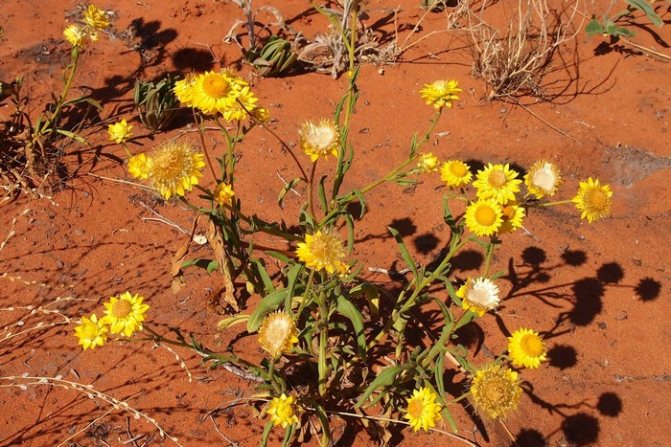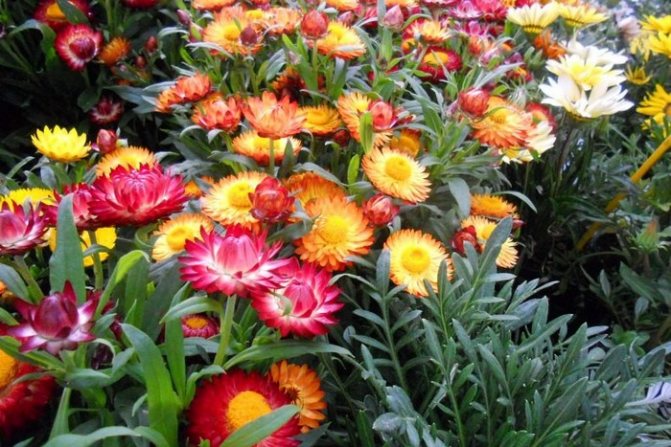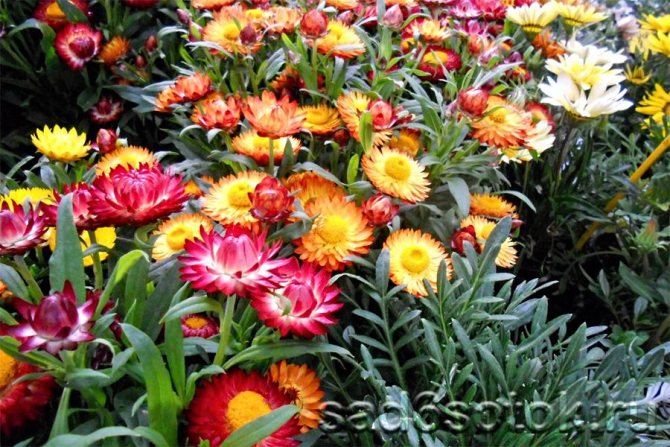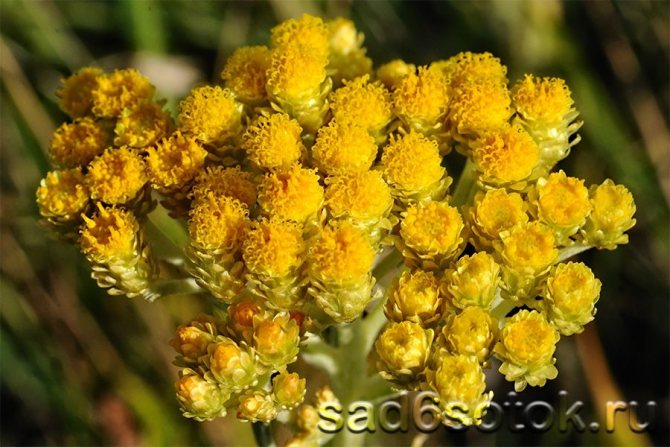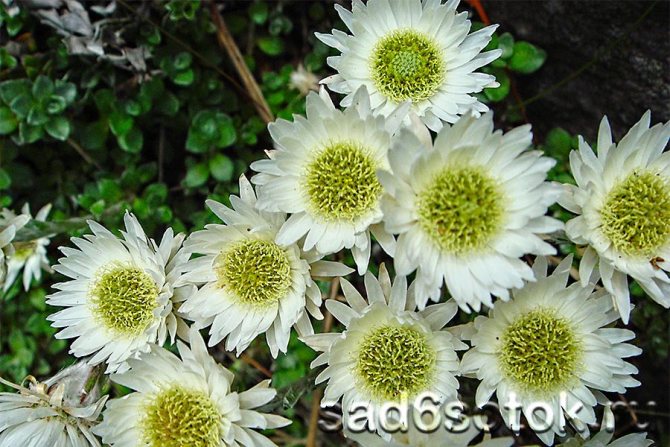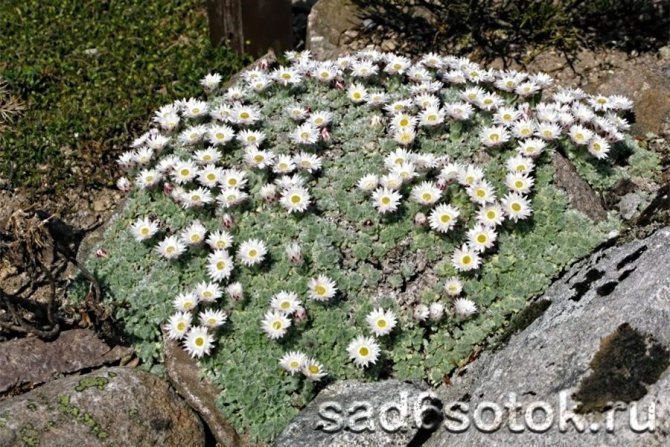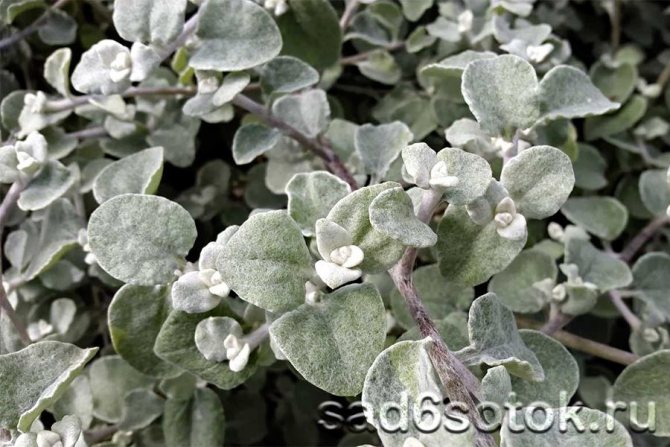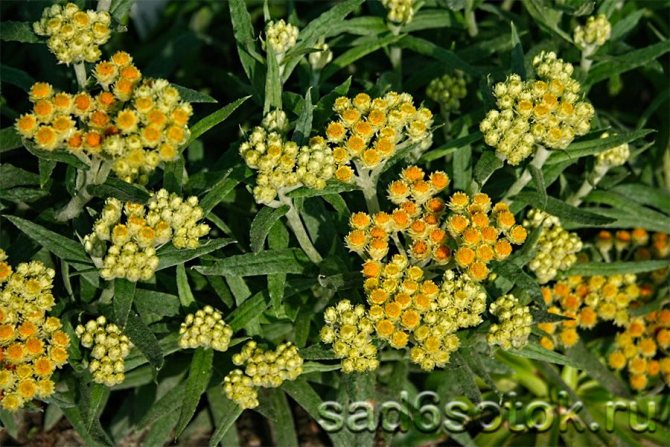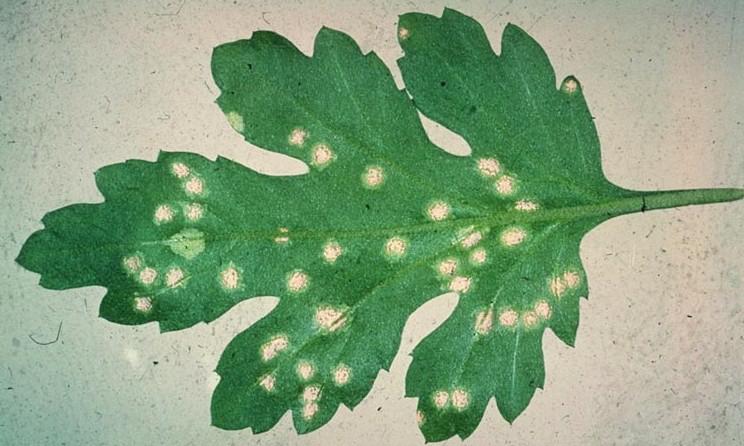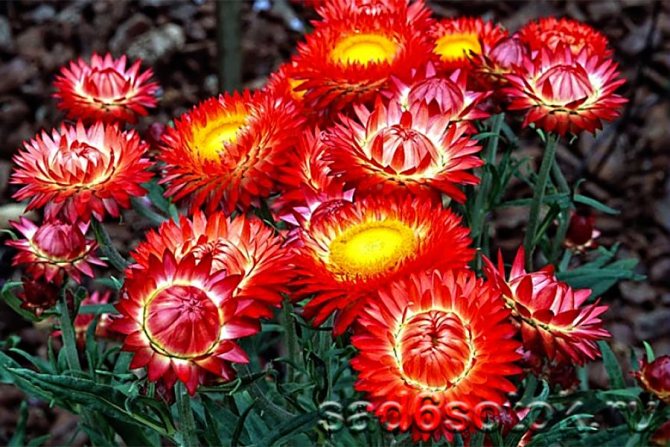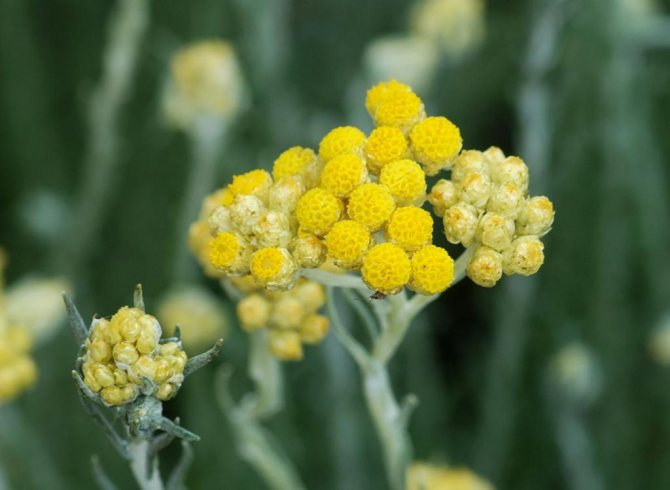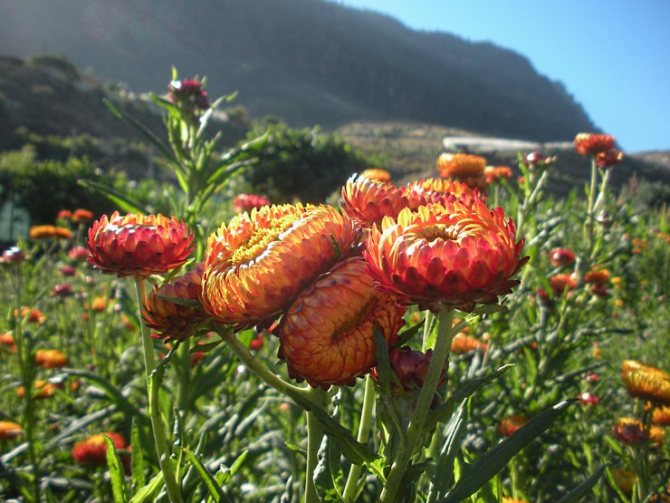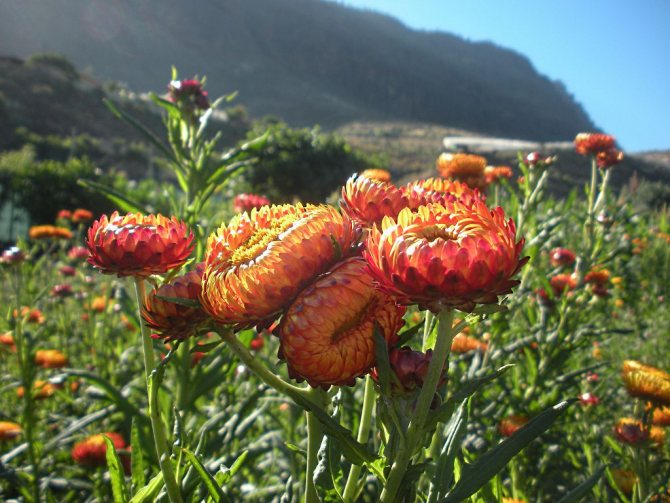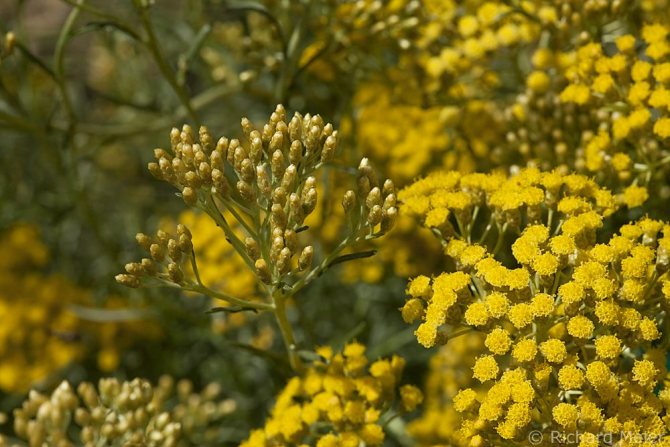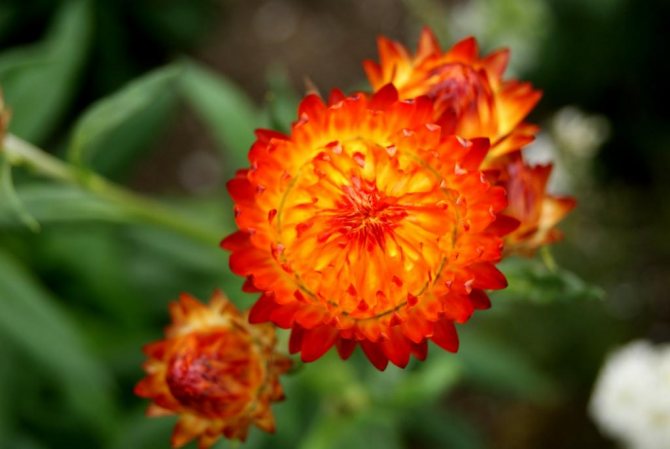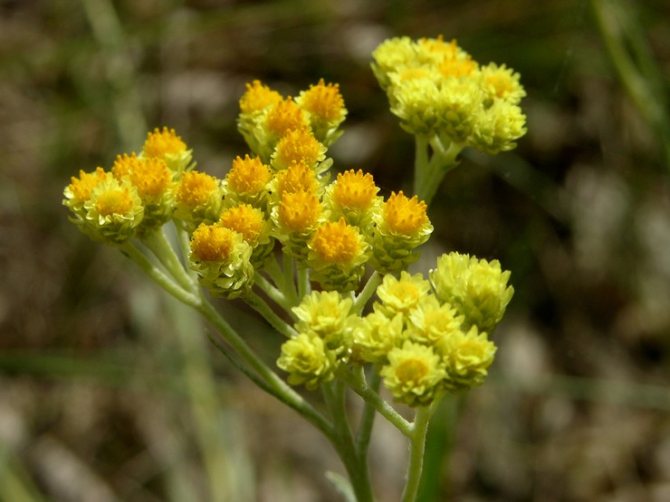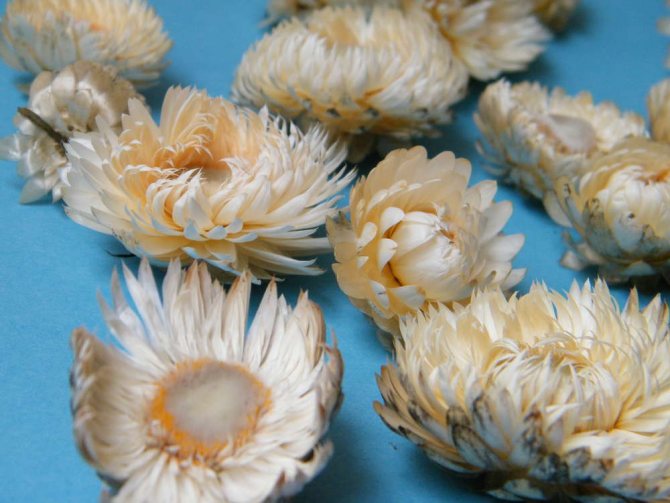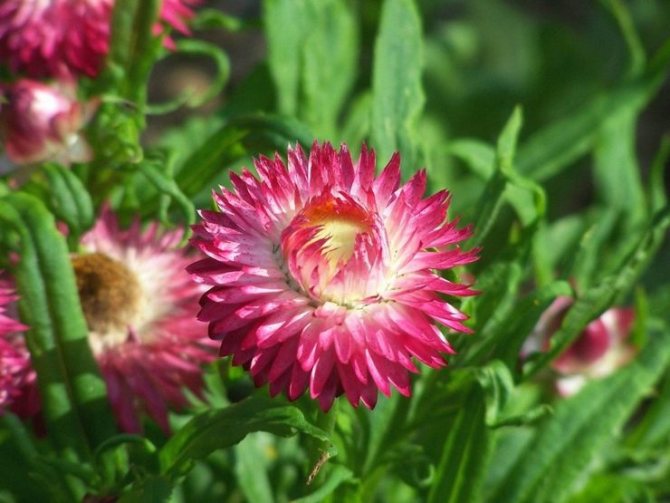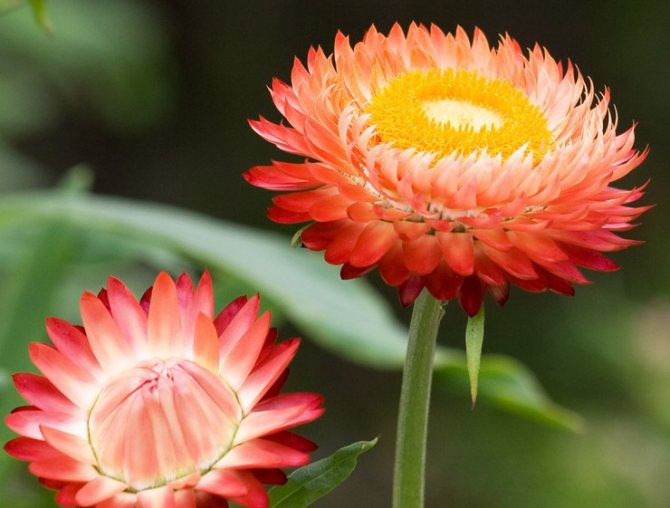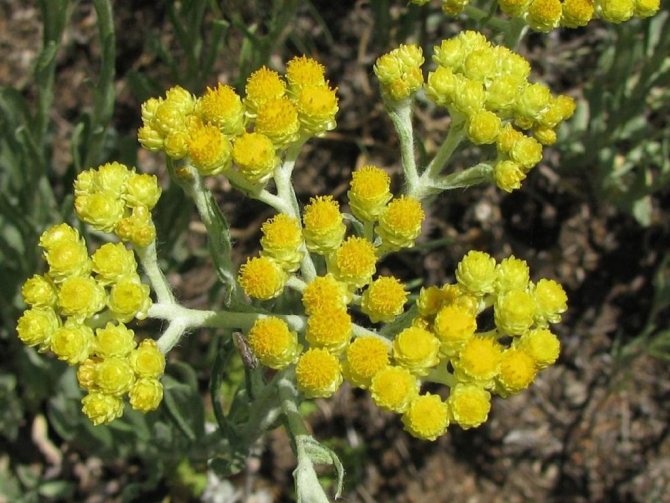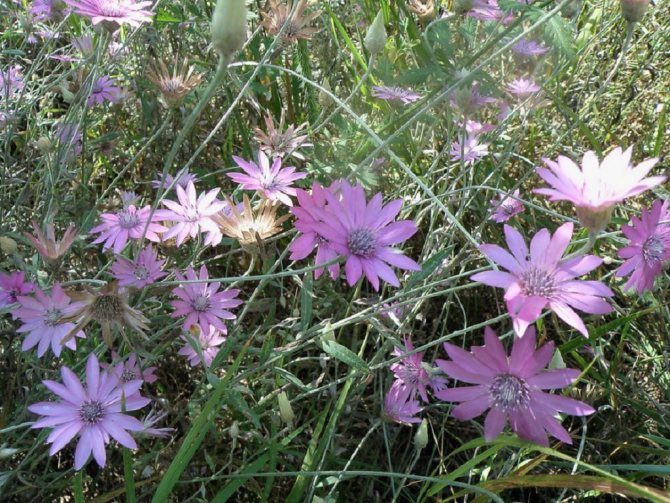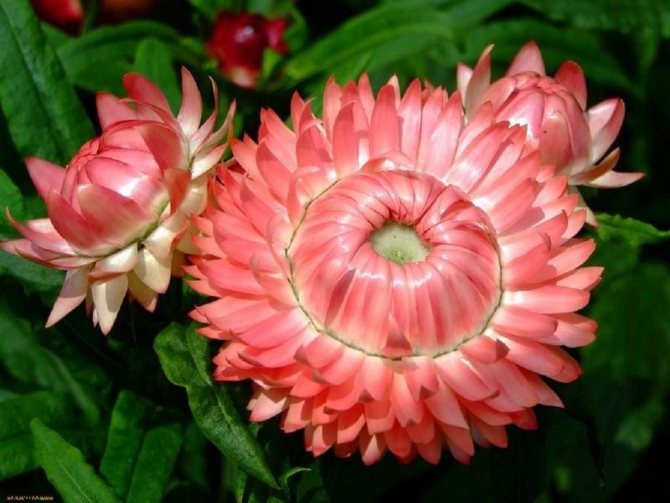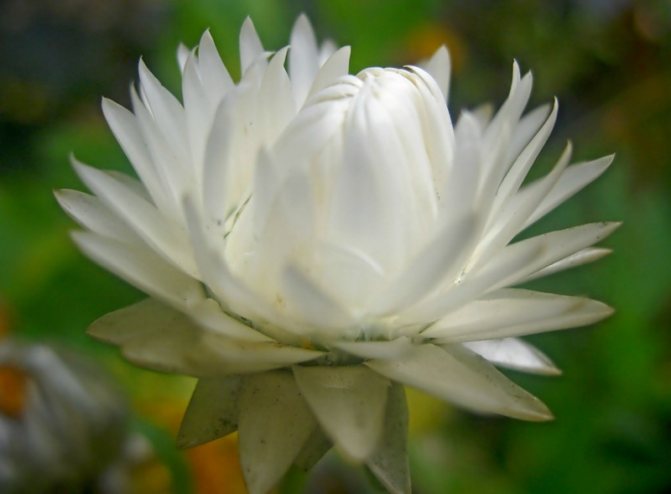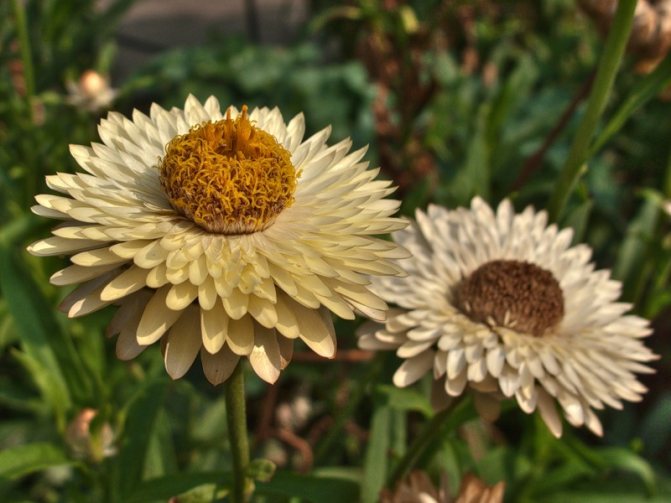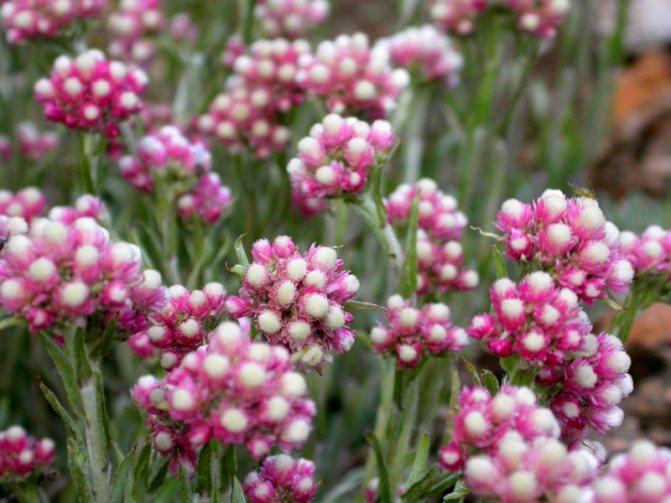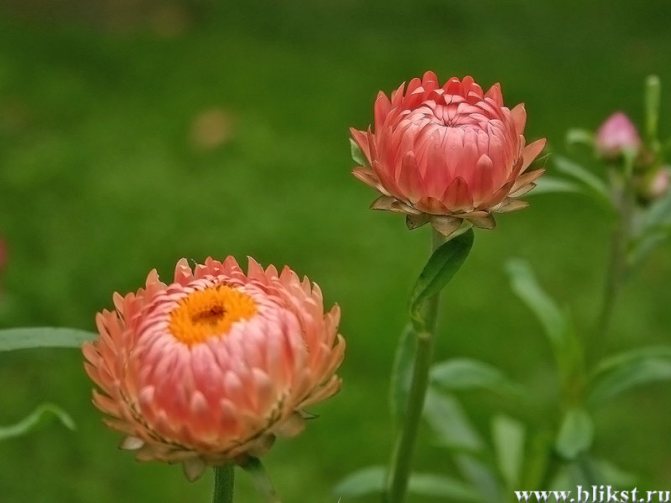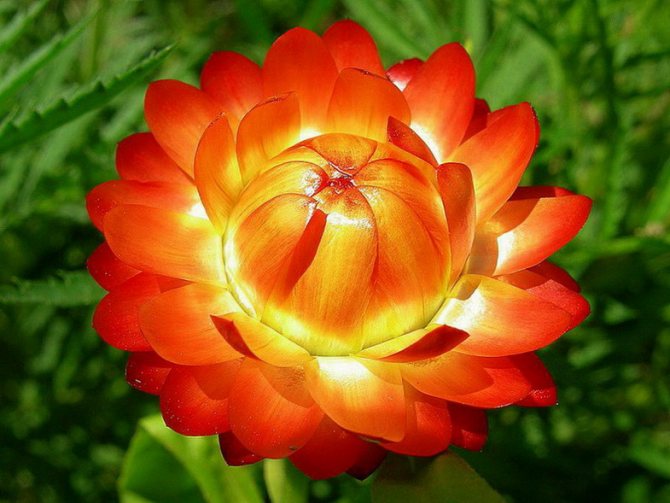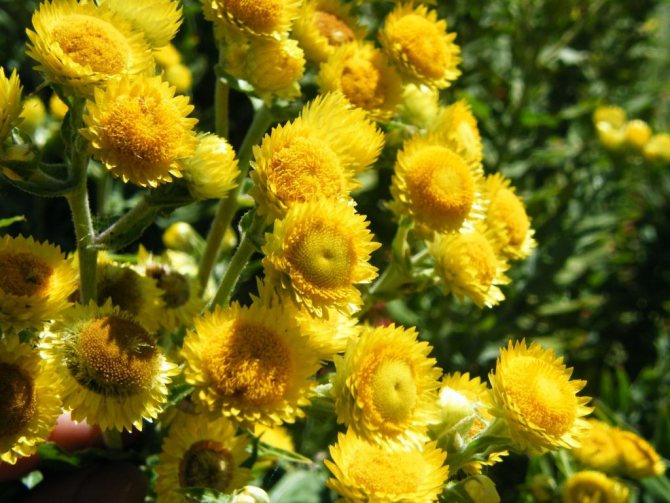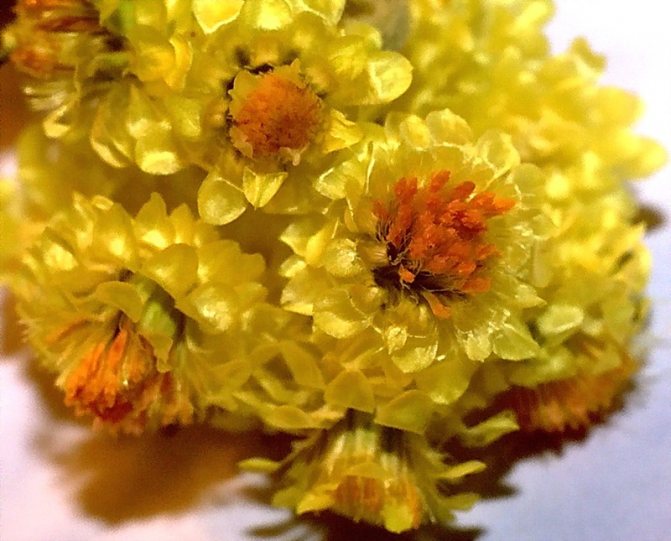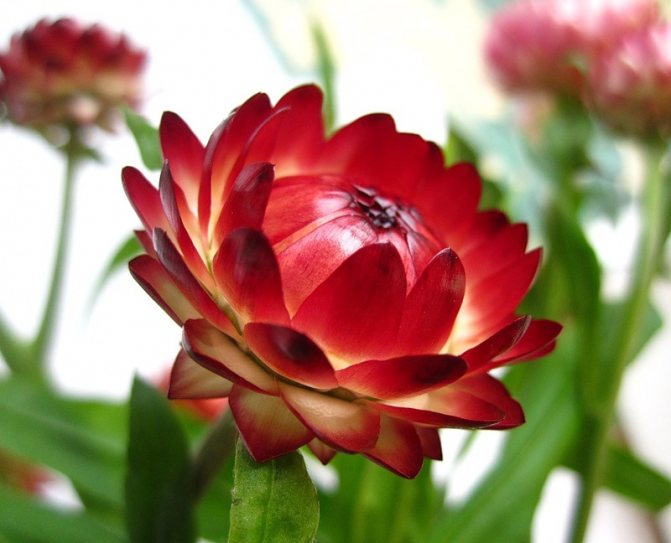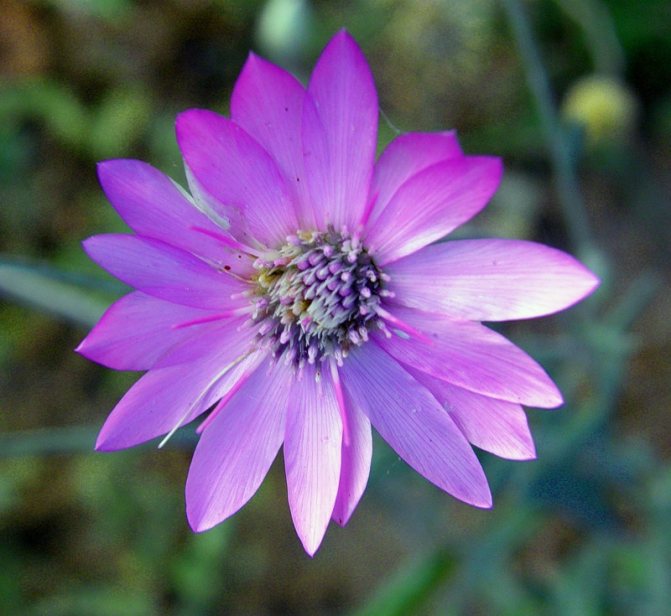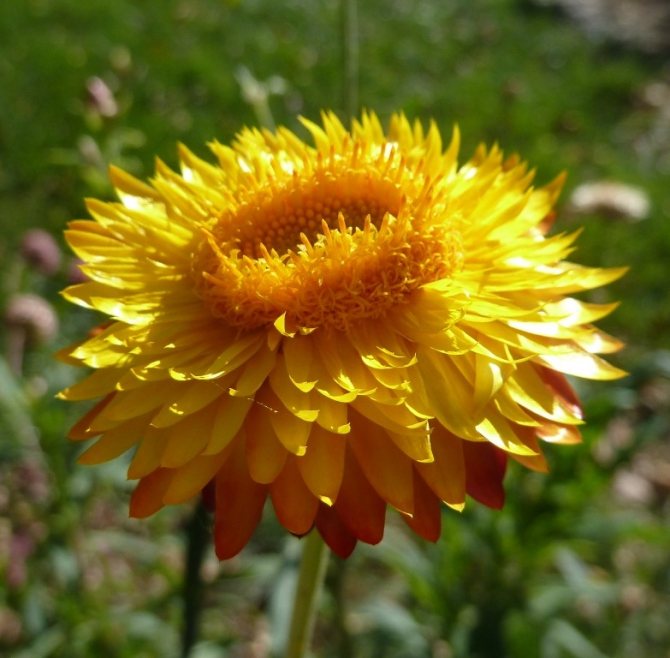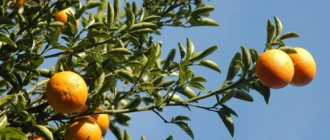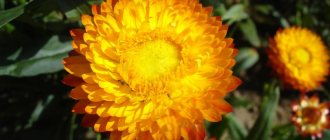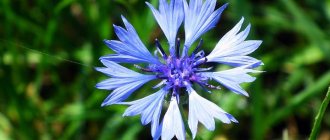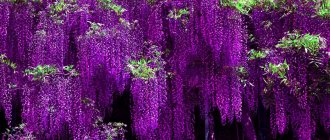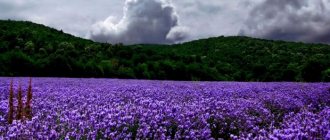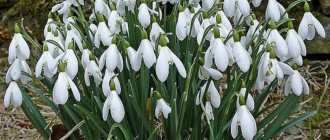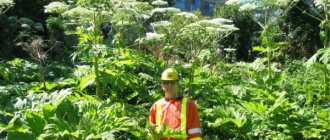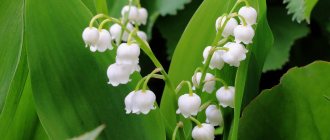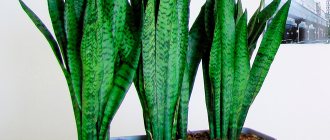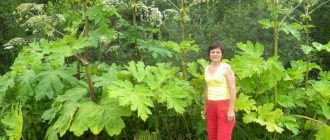Bracts immortelle, or bracts gelichrysum (Xerochrysum bracteatum), called tsmin, zheltyanka or goldflower, belongs to the Astraceae family.
There is a bit of confusion with the immortelle. Taxonomists, based on modern research results, change the name of the species for the third time. The old names remain synonymous. The earliest name is Helichrysum bracteatum, later it was transferred to another genus with the name Bracteantha bracteata, now called Xerochrysum bracteatum.
Immortelle bracts short-lived perennial, grown as an annual plant. Simple, raised, empty inside and rarely branched stem. Leafy shoot. The leaves are dark green with a slight grayish tint. The leaves are rather long (about 10 cm), lanceolate. Stems and leaves are coarsely hairy. At the top of each shoot there are inflorescences typical for the family - baskets. The inflorescence is different from others. True flowers are tubular and are found only in the center of the flower. The petals are actually colorful bracts, transformed leaves. Bracts attract pollinating insects. The second distinctive feature is the papery dryness of the bracts, they are dead cells, the walls are filled with a special substance, like human hair, and they also consist of dead cells. After pollination of tubular flowers, small four to pentahedral achenes are formed, equipped with a flying tuft to facilitate the distribution of seeds in the wind.

The Germans were the first (in the middle of the 19th century) to start growing varieties of immortelle. New breeding methods have led to the emergence of a large number of varieties with larger flowers, new varieties are devoid of the disadvantages of early varieties, in which dry bracts did not fully open.
The history of the spread of the flower
Since this flower became known in ancient times, the first recipes with its use date back to the 6th century BC, the people managed to come up with different names for him, which have survived to this day.
There is information about Tibetan healers who used the beneficial properties of this flower. And in Europe, the immortelle, came from the Australian continent in the eighteenth century. There he became known under the name "Golden Sun" in Latin.
But among the people such a name did not really take root, and therefore many other names appeared, which are used now, calling the flower immortelle. Dried flowers, sandy cmin, sandy cumin, cat paws - all this is one medicinal flower, which is so necessary for various recipes of traditional medicine.
Botanical description
Gelichrisum belongs to the Asteraceae family. In all plants of this group, the inflorescences are baskets. In the botanical reference book Gelikhrizum is included under the name Tsmin.
Gelikhrizums bloom for a long time - from mid-summer to frost. At the end of the season, seeds form in the baskets. The fruit is a small achene, equipped with a tuft like a dandelion and capable of flying under the influence of the wind. A gram contains 1500 pieces. Germination capacity lasts no more than 3 years.
Among the immortelles, there are species with different lifespans.Perennials in our climate are grown as annuals.
The most popular type of cmin is large or bracts. This is a perennial, but summer residents grow it as an annual. The plant can be dug up in the fall with a clod of earth, transplanted into a pot and stored in the room. In the spring, the overgrown bush is divided and planted again in the flower bed.
Tsmin structure:
- leaves are arranged alternately, sometimes opposite, edges without cuts;
- baskets with one or two rows of stipules;
- extreme flowers are pistillate, central staminate;
- inflorescences grow at the tops of the shoots, one at a time or several;
- the rhizome extends horizontally at the soil surface.
The main feature of gelichrisums is dry, brightly colored wrapping leaves arranged in several rows on the inflorescence. After flowering, they can bend outward or remain closed.
Gelichrizum flowers in the photo:
What does an immortelle flower look like and where does it grow?
To find out what immortelle flowers look like, photos can be found on the Internet and view it from all angles... But be careful with the photo, not all plants that will be called immortelle will belong to the medicinal species. Breeders have bred garden varieties of immortelle, which are completely unsuitable for the manufacture of medicines and tinctures.
You need to be guided by the name sandy immortelle - a photo, which will be represented by lemon-yellow flowers, in large inflorescences located at the tops.
The plant itself grows up to fifty centimeters... Its leaves are light with pointed tips. In nature, it grows well, forming whole glades.
The sandy immortelle plant is widespread in countries such as:
- Russia.
- Ukraine.
- Georgia.
- Belarus.
Such a vast area was mastered by this medicinal plant, because it is in these countries that there is sandy loose soil, which the sandy immortelle prefers.
The period of active flowering for this plant begins in the summer, so the immortelle flower can be seen in the fields, and in the wooded area in the glades all three months of summer.
Growing from seeds
Traditional cultivation of the bracts immortelle is sowing seeds directly into open ground. You can accelerate flowering by sowing seeds indoors, plant seedlings in a permanent place. We will get about 3 weeks of continuous flowering. Do not fill the sown seeds indoors, press them into the ground, the light promotes germination.
It is worth considering purchasing immortelle seedlings. Gardeners stock up tiny seedlings from specialized companies and bring their homes to commercial size.
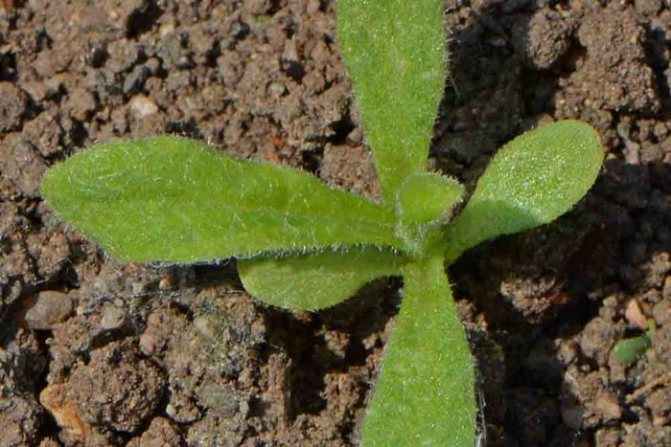

When and how is the immortelle harvested?
For the preparation of decoctions and medicinal preparations, only the flowers of this plant are used. Trunks and leaves of immortelle absolutely useless for traditional medicine. Therefore, herbalists pick only flowered inflorescences, not paying attention to the whole bush.
This medicinal plant is harvested when the flowering period is just beginning, and this usually happens at the beginning of summer. Such a period was chosen due to the fact that it is impossible to allow the flower baskets to completely fluff.
The collected inflorescences are dried in a well-ventilated area. Further storage can be both in glass containers and in cloth bags. If the flower buds were harvested at the right time, properly dried and the storage rules were not violated, then the medicinal properties of the immortelle are preserved for three years.
Varieties and types
In the wild, there are about 500 species of immortelles, no more than 30 have been introduced into culture. Tsmins are suitable for decorating a garden. They are planted in flower beds, in rock gardens and rockeries.
Breeders pay the most attention to Helichrysum bracteatum f. Monstrosum.
Several of its garden forms and varieties with baskets of various colors have been bred:
- white;
- pinkish;
- orange;
- all shades of yellow and red.
Single-row or multi-row petals. In the latter case, the inflorescence looks like terry.
The diameter of the basket is 4-5 cm. Tetraploid varieties with larger baskets (up to 7 cm) have been obtained.
Most varieties have long stems and many branches. Plant height reaches 0.8 m. There are dwarf cultivars. So, the Bikini garden group has a bush height of only 25 cm.
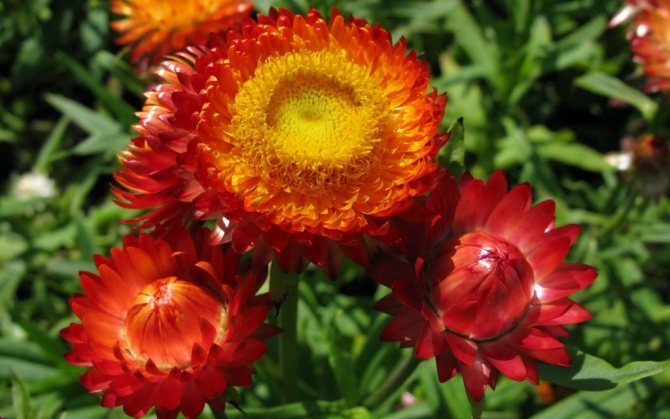

Bikini hot red
Gelikhrizum bracts, popular varieties:
| Name | Height, cm | Diameter (cm) and color of the basket |
| Marshmallow | 100 | 5, white-pink |
| Safari | 100 | 5, salmon |
| Twinkle | 100 | 5, dark red petals, yellow center |
Helichrysum angustifolium or narrow-leaved cmin is very different from other immortelles. It is planted not for cutting flowers, but for the sake of openwork grayish greenery.
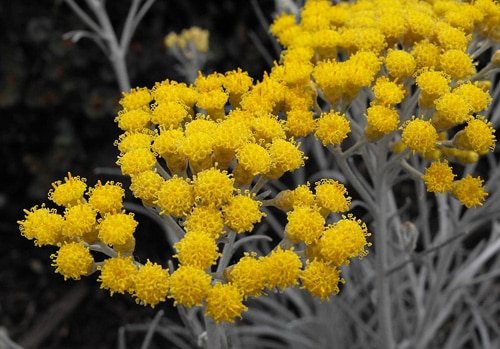

Gelikhrizum narrow-leaved
Gelikhrizum petiolate or licorice native to South Africa. Height 150 cm, bush diameter up to 150 cm. It is an evergreen weaving on the ground with fluffy grayish leaves and small white flowers. The foliage smells like licorice.
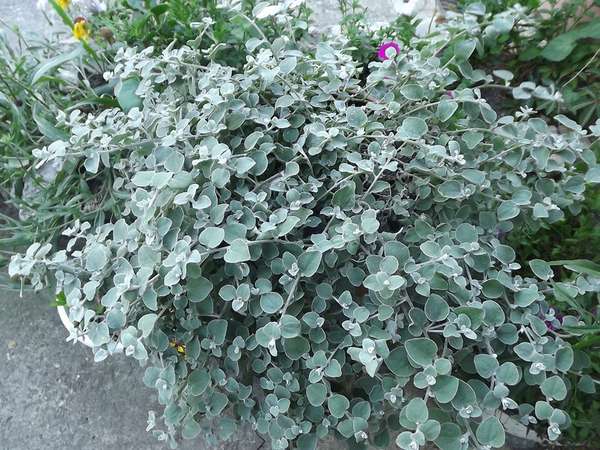

Gelikhrizum petiolate
On the alpine slides, low-growing, bright-flowering tsmini are grown:
- subulate (Subulifolium) - height up to 40 cm with bright yellow inflorescences with a diameter of 2 cm;
- helmet-shaped (Casssianum) - height up to 40 cm, inflorescence width 1 cm, baskets are collected in shields up to 7 cm in diameter, bracts are pink;
- Milfordova (Milfordiae) is an evergreen perennial creeping plant for an alpine garden up to 10 cm high and up to 50 cm wide with chamomile-like white flowers decorated with a yellow center.
Tsmin Milfordova blooms from May to July. In southern climates, it can winter if you cover it with glass. Over the years, plants form a low, dense rug that repeats the contours of the relief and stones, giving many flowers.
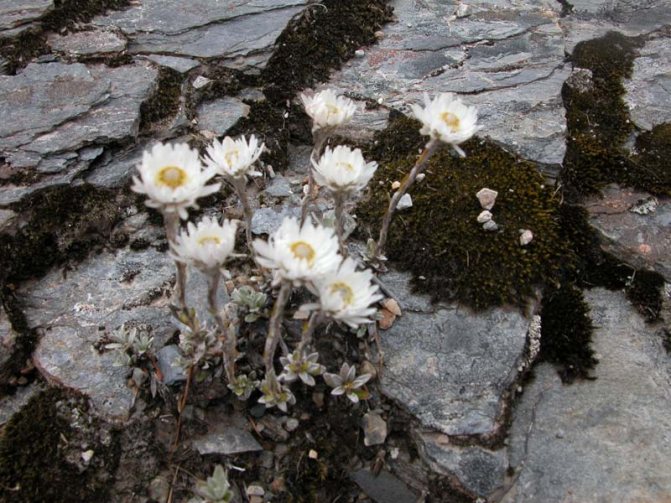

Gelikhrizum Milfordova
Low-growing species look great in low bouquets and rocky gardens. Their blossoming baskets do not lose their brightness for several weeks.
Not all immortelles are from Australia. Several species also grow in our country.
Sandy (Arenarium) is a representative of the flora of the European part of Russia, the Caucasus and Siberia. It is a perennial plant with very small, yellow or orange flowers of regular shape. The inflorescences are large and dense. It blooms from mid-summer until frost, requiring no maintenance. The height of the shoots is 10-50 cm.
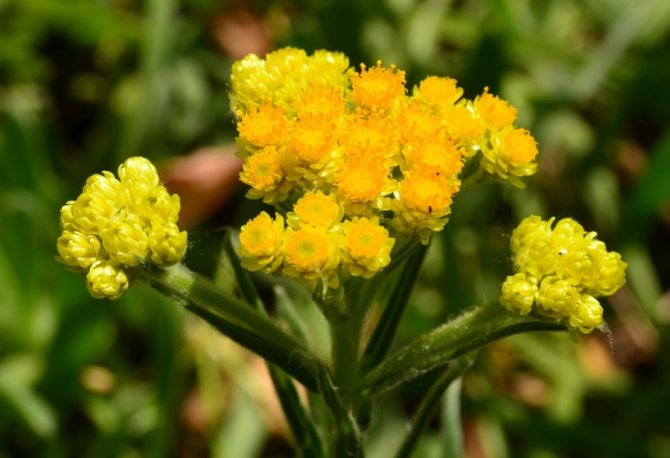

Gelikhrizum sandy
Tianshan (Thianshanicum) - perfectly winters in central Russia without any shelter. In June-July, it is covered with yellow inflorescences. The plants look like sandy cmin, but the leaves are more gray in color.
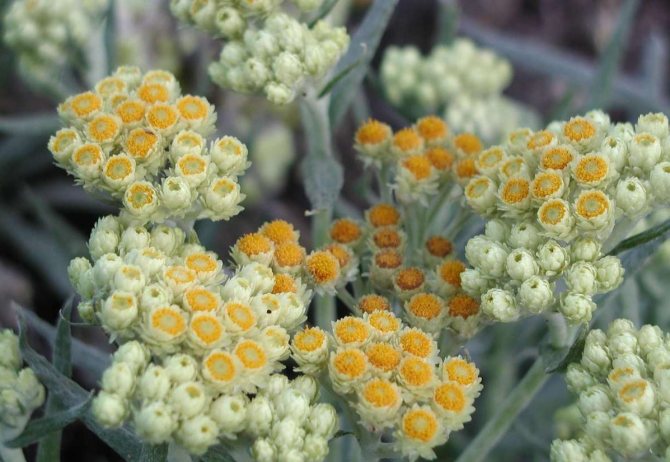

Gelikhrizum Tien Shan
Any immortelles can be used in winter bouquets. Flowers are cut in an unblown state and hung upside down with their heads under a canopy.
Silica gel drying allows processing of flowers with large heads. Gelikhrizums dried in gel withstand humid air, therefore they are suitable for decorating bathrooms.
After drying in the gel, the gelichrizums are placed on the wire, bending its upper edge with a crochet hook. Such a frame supports the heavy flower head in an upright position.
Biochemical composition of the flower
This flower combines a unique composition of substances that will be of interest to any herbalist. Present in the composition essential oils allow you to distinguish this plant by its pronounced aroma and bitter taste. Flavonic acids, tannins and coloring agents, this is an incomplete list of useful substances.
Also in the composition there are vitamins and minerals that have a healing effect on the body. Pharmacists indicate the presence of ascorbic acid, aglycone, cresol, glucose, fatty acids.
Legends of the immortelle
In fact, there are several legends about the origin of this plant. One of them tells that the origin of the flower is associated with the invasion of the Tatar-Mongol horde.
Once a woman came to Khan Batu and began to ask him to allow her to redeem her brother. In response to her plea, Batu picked the first flower he came across and ordered her to walk through the Horde camp until the plant he had picked withers. Anyone the woman found in the khan's camp, she could take with her without paying a ransom. The immortelle flower, with the photo of which you have seen in this article, not only did not wilted during the search for a woman, but, on the contrary, became only more beautiful, filled with the great love and sadness of its companion. With an immortal flower in her hands, a compassionate woman saved the lives of those who met her on the way.
Beautiful yellow flowers to this day protect the eternal sleep of those killed on the mounds and mass graves, recalling the feat in the name of the motherland.
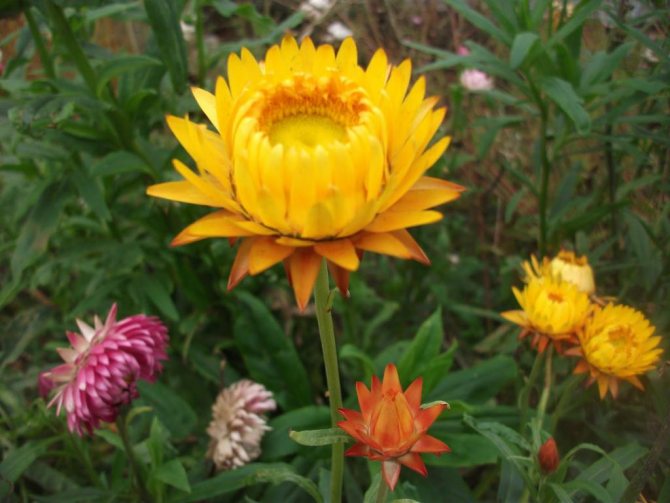

The immortelle has long been used to decorate the home. The semi-handicraft type plant was dried and then graceful fragrant bouquets were formed from its branches. Sometimes this composition was supplemented with other dried herbs. Floral decorations could be found on the walls of rooms, surrounded by silk ribbons and bird feathers.
The tradition of decorating houses in this way originates from ancient Roman custom. According to Pliny, in the winter season, the Romans prepared garlands from immortelle flowers, since there were simply no other varieties there. Flower arrangements from immortelle in that time immemorial were considered a pleasure not cheap. And it is not surprising, because they were supplied from Egypt or Greece.
The girls loved to scent the plants with perfume - so the immortelle acquired a greater resemblance to fresh flowers.
Pharmacological properties of immortelle
The most important properties that herbalists first noticed are the antibacterial and anti-inflammatory effects that this plant has on the body. Long-term medical practice has also proven the antispasmodic, diuretic, wound-healing and choleretic properties of the immortelle.
Already in the twenty-first century, modern medicine has confirmed it healthiness and usefulness for the body.
As a rule, immortelle flowers are included in different collections, which are selected for a specific clinical case by herbal specialists. These lemon-yellow flowers will help you tune your gallbladder. Decoctions and tinctures based on it will increase appetite, blood pressure with hypotension, and remove harmful cholesterol.
The antibacterial effect caused by the substance arenarin will help relieve irritation and perform disinfecting procedures.
The essential oils of this plant are used for massages, baths, and cosmetic procedures. Also added to creams for various purposes and aroma lamps.
What should be the care of an immortelle?
As already noted, it is not difficult to take care of a flower, but this does not mean that the plant, in general, can be left to its own devices. In order for the immortelle to bloom in mid-July, you will have to work a little.
To do this, let's find out what the Tsmin loves:
- Priming. Like any plant, cmin needs good fertilization of the substrate. Therefore, before planting seeds, it is advisable to fertilize the soil with specially purchased compounds or compost. And so that the root system has something to "breathe", provide a normal drainage system for the flower;
- Lighting. Gelikhrizum loves a lot of light, so it is advisable to plant it in a sunny area of a flower bed. Almost all varieties of culture stoically endure even extreme heat, however, species such as "licorice" should be protected from intense sunbathing;
- Fertilizer.Annual plants practically do not need additional feeding, but perennial plants will have to tinker a little. Long-blooming immortelle must be fertilized with liquid formulations or compost in August;
- Watering. A garden flowering immortelle flower needs regular watering. This is especially true for varieties that "love" the sun. It is advisable to water the crop twice a day in summer, when the sun is inactive, i.e. in the morning and in the evening.
Indications for use
Preparations prepared on the basis of immortelle, successfully used in urology... Healing properties help to cope with pain syndrome, remove spasms and produce disinfection.
Decoctions from these flowers are also valuable for improving the functioning of the intestines. With their help, you can remove persistent constipation and restore peristalsis.
Cholesterol plaques on the vessels can be removed with immortelle treatment. This will allow the vessels to work normally, absorbing nutrients in full. The flowers of this plant allow wounds to heal faster, stop bleeding, and promote the resorption of hematomas.
Planting and care at home
In apartments, Gelechrisium looks very beautiful not only in the form of decorated dry compositions. It can be grown on the balcony. To do this, they are planted in hanging pots and balcony boxes.
For planting, use a universal soil. But it is best to collect land in the forest. You can add compost and mineral fertilizers to it. It is necessary to grow the plant on the sunny side.
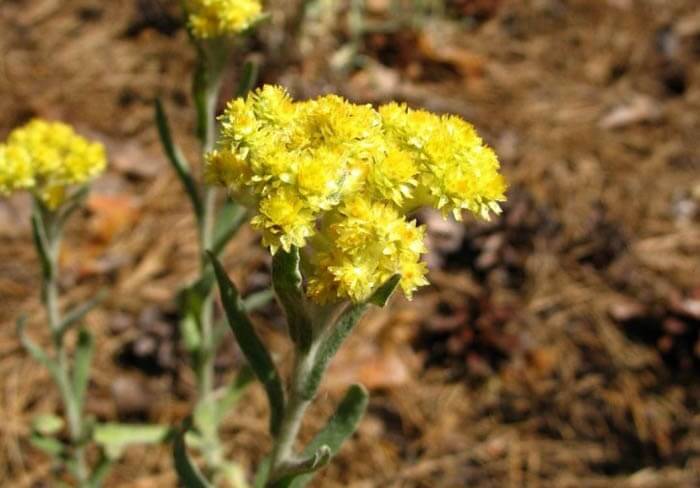

The immortelle does not tolerate excess moisture well. Therefore, it should be watered no more than 3 times a week. Pour fine gravel on the bottom of the box before planting. Tsmin looks effective in compositions with white and red pelargonium, petunia, evening primrose.
It's important to know! In order for a flower to grow at home, it needs good lighting. You can set the backlight using a special UV lamp.
Harm and contraindications
Individual intolerance can become an obstacle to the use of immortelle decoctions. Overdose should also be avoided.
You should not take decoctions of this herb for a long time, as the immortelle has a tendency to accumulate in the body, which negatively affects the liver.
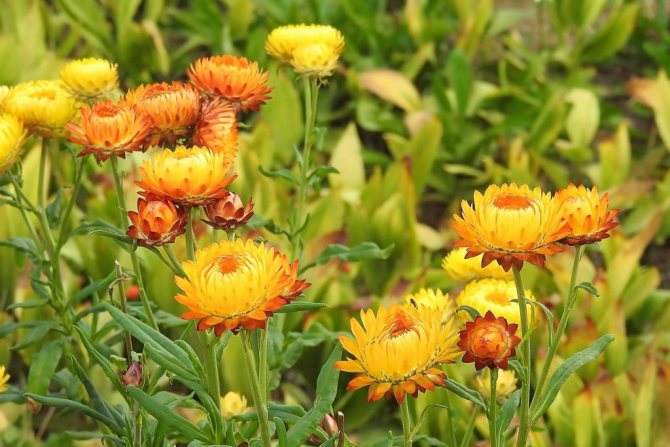

People with atherosclerosis and hypertension should not get carried away with prolonged intake of decoctions.
Immortelle medicines are contraindicated for people with obstructive jaundice.
You can not use the immortelle with increased acidity of the stomach.
That's all that could be said about the immortelle. You could familiarize yourself with the photo of the herb in the article, and its harm and benefit specifically in your case are still determined by your doctor!
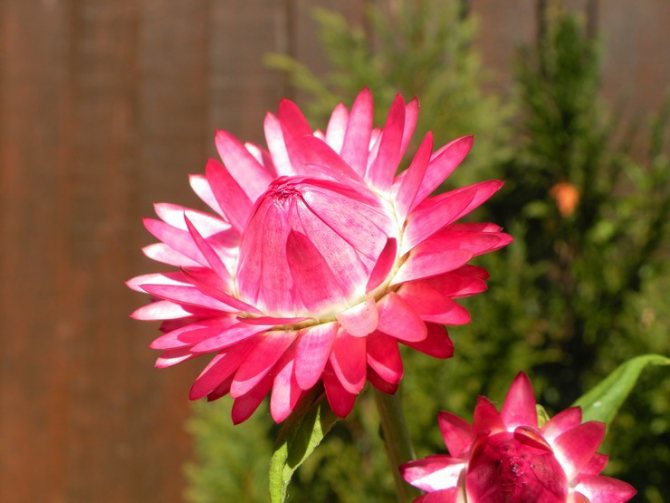

The immortelle (Helichrysum) is a herbaceous perennial that belongs to the Asteraceae family. In addition to the main name, you can hear the plant address cmin, zheltyanka or helihrizum. Shoots branch out to the sides and are decorated with inflorescences of various colors. The buds are hard to the touch. Their beauty lasts for a long time. Drying, the petals seem to freeze and still look bright and attractive.
The origin of the flower began in Africa, then the immortelle was brought to Australia and the countries of Asia Minor. The immortelle herb is popular in the organization of landscape design, has medicinal properties, is used in medicine and as an element of floristry. There are many subspecies in the genus, thanks to which immortelle compositions will be an excellent basis for any bouquet. To get a beautiful and healthy flower garden, you must adhere to the recommendations for growing immortelle from competent gardeners.
Using
Immortal is used to create alpine slides, mixborders. Low-growing varieties are used as curb plants.Tsmin looks good next to the seaside cineraria. Basically, gelichrizum is grown for cutting, for drawing up live and dry bouquets.


Similar articles:
- Woodruff (Asperula)
- Lonas
- Sanvitalia
- Xerantemum
- Collinsia
- Carnation Shabo

